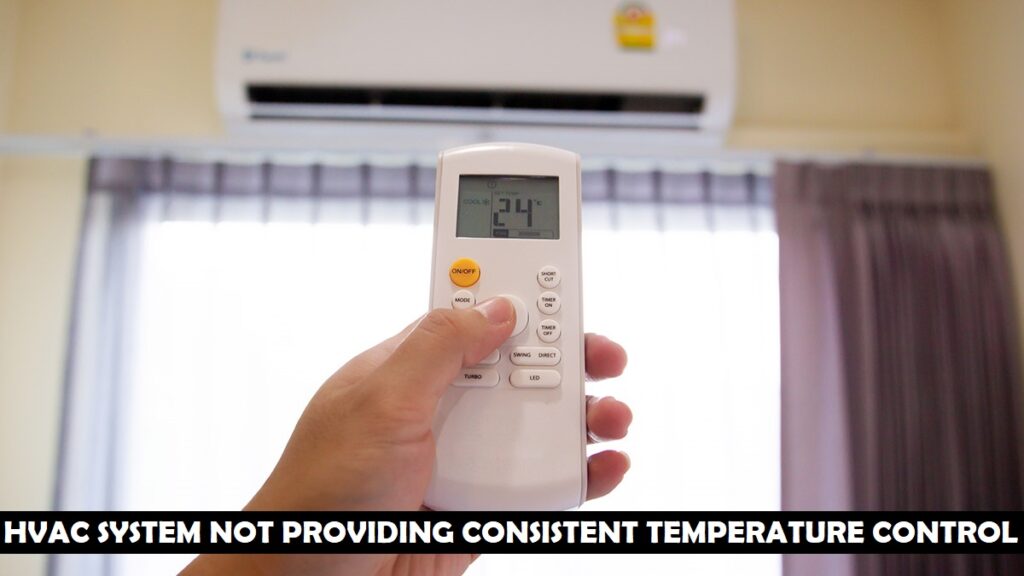Your home’s HVAC (Heating, Ventilation, and Air Conditioning) system is your lifeline to comfort, especially when the weather takes extreme turns. However, what do you do when it starts failing you, unable to maintain a consistent temperature throughout your living space? In this in-depth guide, we will delve into the intricacies of troubleshooting and resolving this pervasive issue that many homeowners face – inconsistent temperature control.

Understanding the Problem
Identifying the Symptoms
The first step in resolving any issue is recognizing its symptoms. When it comes to inconsistent temperature control, these symptoms can manifest in several ways. You might notice that some rooms in your house feel uncomfortably warm, while others remain chilly. Alternatively, your HVAC system might seem to be in a constant battle, cycling on and off in an attempt to maintain the desired temperature.
Possible Causes
To effectively address the problem, it’s crucial to understand what’s causing it in the first place. Several factors can contribute to inconsistent temperature control, and pinpointing the root cause is essential for an effective solution.
One common culprit is dirty air filters. When these filters become clogged with dust and debris, they restrict airflow, making it harder for your HVAC system to distribute conditioned air evenly throughout your home.
Another potential issue lies with your thermostat. If it’s not calibrated correctly, it can lead to temperature discrepancies. A few degrees off can result in certain rooms feeling too hot or too cold.
In some cases, the problem might stem from the ductwork. Leaky or damaged ducts allow conditioned air to escape before it reaches its intended destination. This can result in uneven heating or cooling throughout your home.
DIY Troubleshooting
Check Your Air Filters
One of the simplest yet most effective steps you can take is to inspect and replace your air filters regularly. Air filters are the first line of defense in your HVAC system, trapping dust, pollen, and other airborne particles. Over time, they can become clogged, restricting airflow and forcing your system to work harder.
To check your air filters, locate them in your HVAC system (usually near the return air duct). Remove the filter and hold it up to the light. If you can’t see light through it, it’s time for a replacement. Depending on usage and the type of filter you have, this may be necessary every one to three months.
Calibrate Your Thermostat
Calibrating your thermostat may sound like a daunting task, but it’s a relatively simple process that can make a significant difference in your home’s comfort. A poorly calibrated thermostat can lead to temperature variations that leave you feeling too hot or too cold.
To calibrate your thermostat, follow these steps:
- Remove the thermostat cover to access the temperature adjustment mechanism.
- Use a small screwdriver to adjust the calibration dial. Make small, incremental changes, allowing time for the thermostat to respond before making further adjustments.
- Use an accurate thermometer to monitor the temperature in your home and ensure it matches the thermostat’s reading.
Inspect Your Ductwork
Your HVAC system’s ductwork is like the circulatory system of your home, carrying conditioned air to every room. If there are leaks or damage in the ducts, it can disrupt the even distribution of air and result in inconsistent temperatures.
Inspecting your ductwork involves:
- Visually checking for visible damage, loose connections, or disconnected ducts.
- Sealing any gaps or holes with specialized duct tape or mastic sealant.
- Ensuring that ducts are properly insulated, especially in unconditioned spaces like attics and crawl spaces.
Professional Help
When to Call an HVAC Technician
While DIY troubleshooting can address many issues, some situations may require the expertise of a professional HVAC technician. Here are instances when it’s best to seek professional help:
- Refrigerant Issues: If your HVAC system is low on refrigerant, it can’t cool your home effectively. This is a task best left to professionals, as handling refrigerant requires specialized training and equipment.
- Electrical Problems: If you suspect electrical issues are affecting your HVAC system, such as faulty wiring or a malfunctioning control board, it’s essential to call a qualified technician to avoid safety hazards.
- Complex Repairs: For major repairs or replacements, such as a compressor replacement or a new HVAC system installation, professional help is crucial to ensure the job is done correctly.
Regular Maintenance
Prevention is often the best solution to avoid inconsistent temperature control in your HVAC system. Scheduling regular maintenance with a qualified technician can help you identify and address potential issues before they become major problems.
During a maintenance visit, an HVAC technician will:
- Clean and Inspect Components: This includes cleaning the coils, checking electrical connections, and ensuring all parts are in good working condition.
- Test Thermostat Calibration: Technicians can verify that your thermostat is accurately reading and controlling the temperature.
- Check Refrigerant Levels: They will ensure that your system has the right amount of refrigerant for optimal performance.
- Inspect Ductwork: Technicians can spot and repair any issues with your ductwork, ensuring that air flows smoothly to every room.
Inconsistent temperature control in your HVAC system can be frustrating, but it’s a problem with solutions. By following the steps outlined in this guide, you can regain control over your indoor climate and ensure that your home remains comfortable year-round.
Remember, regular maintenance and attentive DIY troubleshooting can go a long way in preventing and resolving temperature control issues. However, if you ever find yourself facing HVAC troubles that are beyond your expertise, don’t hesitate to reach out to a qualified HVAC technician. They have the knowledge and experience to get your system back on track.




